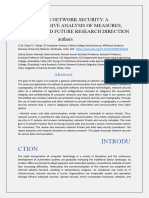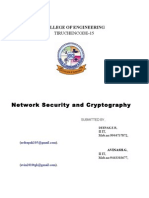0% found this document useful (0 votes)
6 views6 pagesCryptography
Cryptography protects information by converting it into secret codes, ensuring confidentiality, authentication, integrity, non-repudiation, access control, and availability. Organizations must adapt to emerging threats through constant learning, advanced technologies, and strong security policies. Applying network security principles, such as defense in depth and least privilege, helps businesses safeguard against cyber threats and maintain data safety.
Uploaded by
aniket kumarCopyright
© © All Rights Reserved
We take content rights seriously. If you suspect this is your content, claim it here.
Available Formats
Download as DOCX, PDF, TXT or read online on Scribd
0% found this document useful (0 votes)
6 views6 pagesCryptography
Cryptography protects information by converting it into secret codes, ensuring confidentiality, authentication, integrity, non-repudiation, access control, and availability. Organizations must adapt to emerging threats through constant learning, advanced technologies, and strong security policies. Applying network security principles, such as defense in depth and least privilege, helps businesses safeguard against cyber threats and maintain data safety.
Uploaded by
aniket kumarCopyright
© © All Rights Reserved
We take content rights seriously. If you suspect this is your content, claim it here.
Available Formats
Download as DOCX, PDF, TXT or read online on Scribd
/ 6




























































































